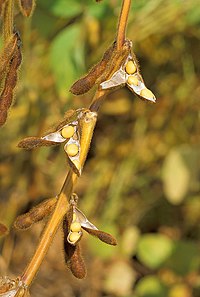
Photo from wikipedia
Quinoa contains rich saponins, which are removed during processing and cause ecological waste. We extracted saponins from quinoa (SEQ) in black, white, and red cultivars and compared their composition by… Click to show full abstract
Quinoa contains rich saponins, which are removed during processing and cause ecological waste. We extracted saponins from quinoa (SEQ) in black, white, and red cultivars and compared their composition by spectrophotometric assay and high-performance liquid chromatography analysis combined with acid hydrolysis. The digestion and fermentation properties of SEQ were investigated using an in vitro model. Our results showed that acid hydrolysis released sapogenins, mainly phytolaccagenin (PA), hederagenin (HD), and oleanolic acid from SEQ. Varying from SEQ in red, SEQ in black and white had a similar composition and content of sapogenins. Gastrointestinal digestion did not release sapogenins from SEQ but reduced the antioxidant activity of SEQ. Gut microbiota from human feces released PA and HD from SEQ. Reciprocally, SEQ in black significantly increased the growth of Lactobacillus spp. and Bifidobacterium spp., while reducing the growth of Shigella spp. The present study provides guidance for further investigation about the bioactivities of saponins from quinoa.
Journal Title: Journal of agricultural and food chemistry
Year Published: 2022
Link to full text (if available)
Share on Social Media: Sign Up to like & get
recommendations!